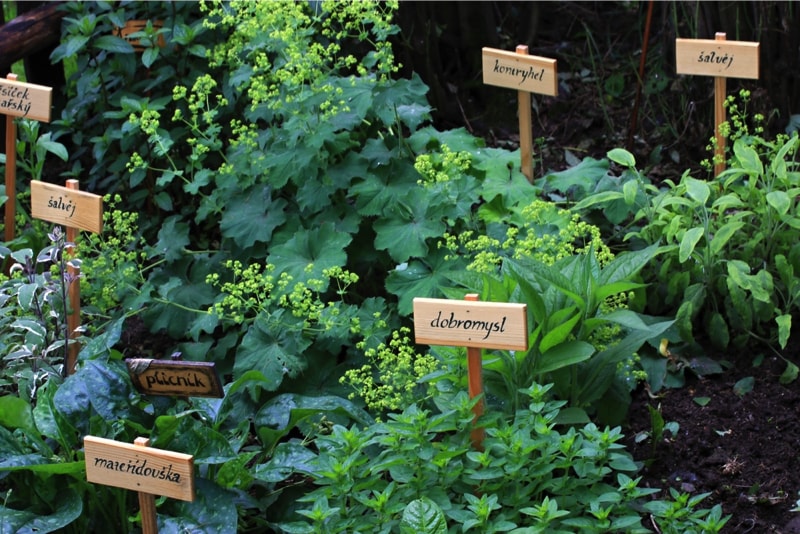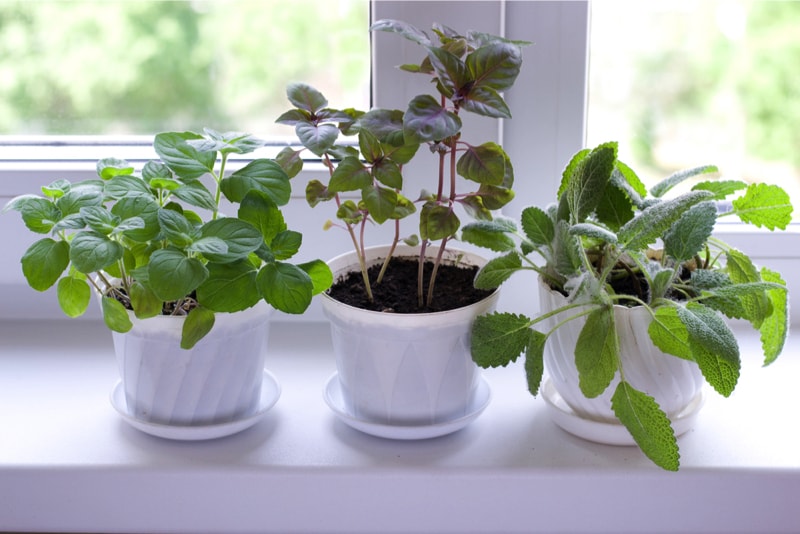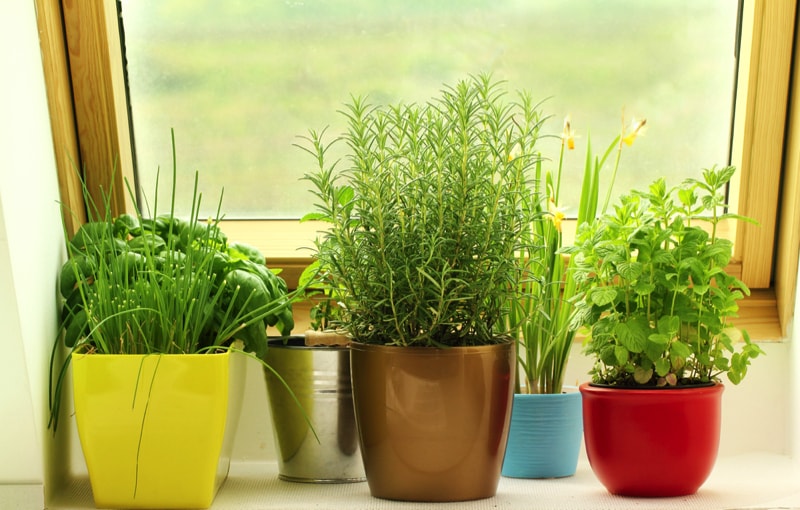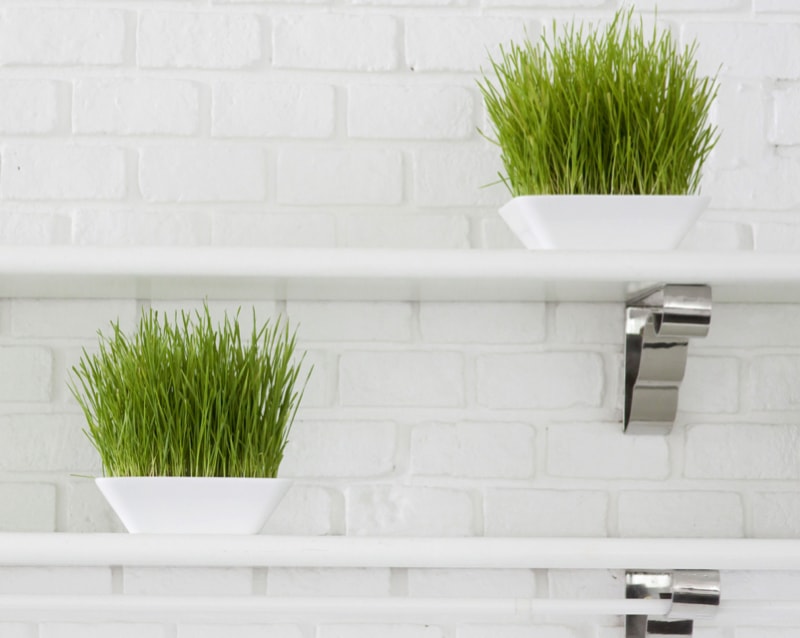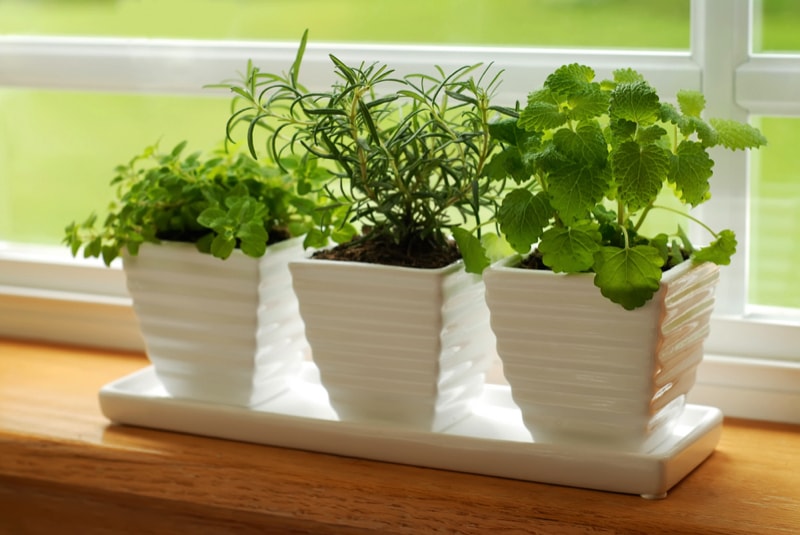 Growing Herbs indoors or beginners -Three pots of herbs in a kitchen window Marjoram, Rosemary, and Lemon Balm.
Growing Herbs indoors or beginners -Three pots of herbs in a kitchen window Marjoram, Rosemary, and Lemon Balm.
Growing an Indoor Herb Garden with your own indoor growing systems at home can be a real convenience, especially of you’re an avid cook. Nothing comes close to having a selection of fresh (organic) home grown herbs at your finger tips to add to your latest cooking masterpieces.
Growing herbs indoors doesn’t require a lot of space, despite what you may think. You can grow a selection of your favorite herbs indoors in an apartment or a mansion. It makes no real difference.
Typically most people will create a herb garden in tiny little pots that they will sit atop a windowsill in their kitchen. This usually means the plant or plants will get the required daily attention it needs to prosper and grow. It also makes it simple and easy when cooking, to just snip a piece or two from the plant without causing it any undue stress, meaning that there will be plenty more to use at a later date. Herbs are usually quite forgiving when you snip a piece or two here or there. They usually bounce back (as long as you aren’t too greedy and brutal) well.
Even if you aren’t fortunate enough to have a sunny spot in your kitchen, all you need is an another room to grow these indoor herbs provided it has regular warmth and sunlight.
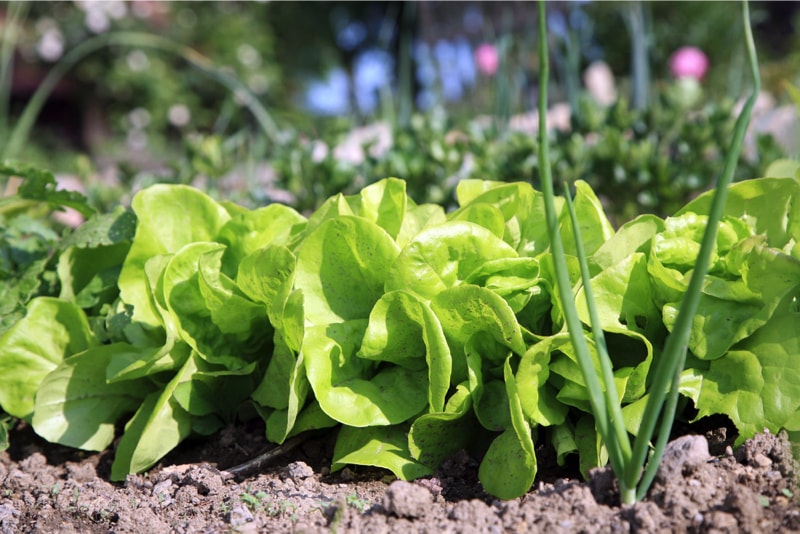 Young lettuce in ecological home garden. Eco-friendly backyard garden, vegetable garden.
Young lettuce in ecological home garden. Eco-friendly backyard garden, vegetable garden.
Page Topics
Finding The Best Spot For Growing Your Indoor Herb Garden?
When it comes to growing herbs indoors, you should find the sunniest spot in your home because herbs require as much natural light as possible. It’s the old story; give a plant sun and plenty of regulated water, and you’ll end up with a decent crop.
From seeds, you need to plant them in a decent pot of soil and then place them in a sunny spot, ideally near a window so that they are likely to receive at least 4 hours of daily sunshine. Depending on which hemisphere you live in, you’ll want to ensure your windows are south facing (for northern hemisphere people) or north facing (if you live in the southern hemisphere). This will ensure that the plants receive the fullest amount of daylight sunshine possible.
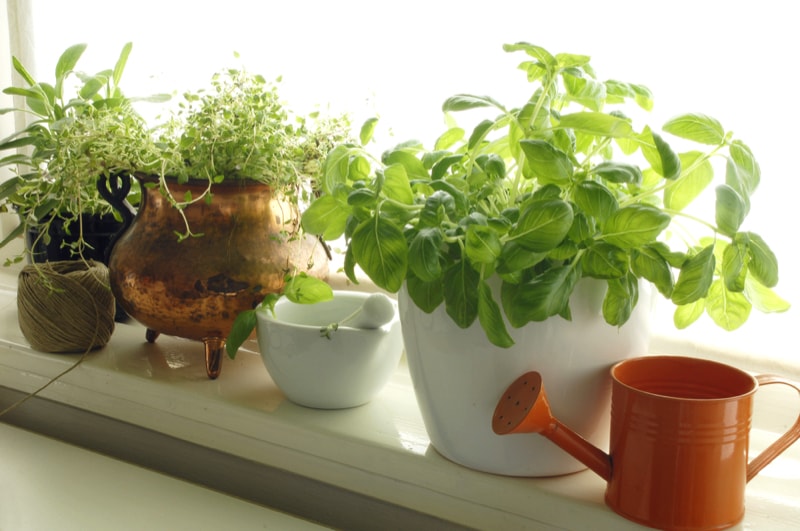 Herbs grow indoors, fresh aromatic herbs in pots on window.
Herbs grow indoors, fresh aromatic herbs in pots on window.
One way to test the amount of sunlight a room (or spot) receives is to turn off all lights in the room and then monitor just how much natural sunlight the room receives during the day. It doesn’t have to be direct sunlight such as full sun rays, however it needs to be light and bright in order to benefit the plant.
Photosynthesis which is the process by which plants turn Carbon Dioxide and sunlight into green foliage is akin to providing any living being with the right energy needs. even us humans require oxygen and food in order to function. On the same note plants need CO2 and sunlight. It is possible to provide plants with plenty of artificial light and this will still result in good quality growth, however, for the best flavorsome end result, you want to provide as close to a natural environment as possible.
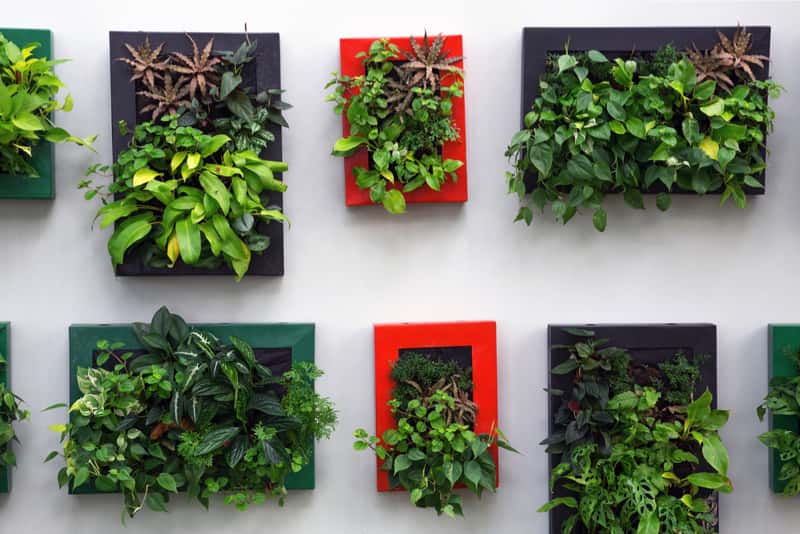 Decoration in the garden and plants in the frame
Decoration in the garden and plants in the frame
Its exceptionally important that you keep your herbal plants well watered, but at the same time, they must also be well drained. Keeping the little pots sitting on a base, or a saucer, will mean that any drain through won’t damage whatever surface you have them sitting on. It’s important that your herb’s roots don’t sit in ‘undrained’ water as this will rot them, and end up killing your plants.
Be careful and pay particular attention to your plants depending on your own home environment. If you are growing herbs indoors and its winter, then be aware, that the internal heating that you use to keep your home warm can also cause your plants to become dry and stressed. keep them well watered, but not overly so. the should should be damp to the touch but not saturated.
You’ll come to realize that most indoor herbs like the internal climate (assuming you take good care of them). Compared to the outdoors, most homes offer a fairly consistent temperature year round, and for this reason, you can comfortably grow herbs inside most of the year. If you can maintain your inside temperature between about 65 and 70 degrees (F), throughout the year, then you’ll achieve the optimum growth temperature for your indoor plants.
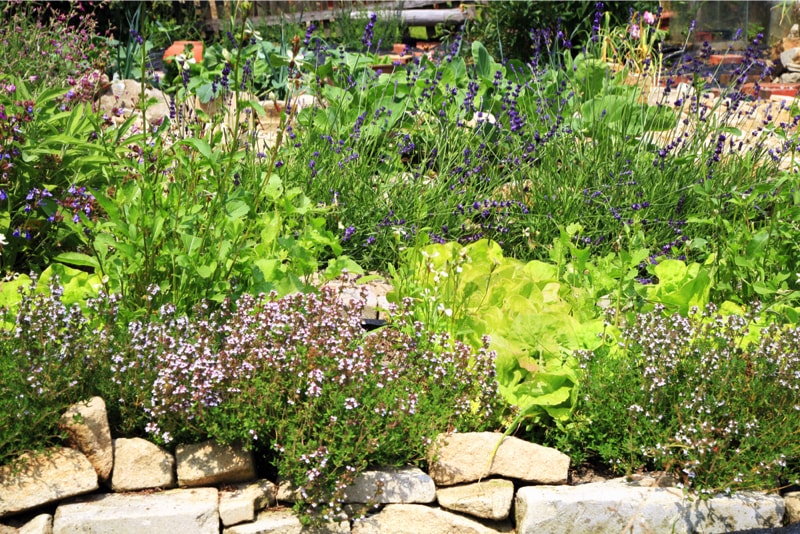 Spring in formal eco home garden. Organic cultivation of herbs and vegetables
Spring in formal eco home garden. Organic cultivation of herbs and vegetables
During winter, (depending of course on where you live) be aware, that the air next to the window can be considerably cooler and also hotter in summer than your ambient inside temperatures, so be careful with their watering and ensure they aren’t in direct contact with the windows as this can cause temperature shock.
You’ll probably find that indoor herbs aren’t quite as generous as their outdoor counterparts when it comes to the way they grow, nevertheless, you should still be able to get a decent volume of clippings during their life. If you do end up harvesting some of their leaves on a regular basis, a little bit of fertilization once a month can assist in maintaining a good crop.
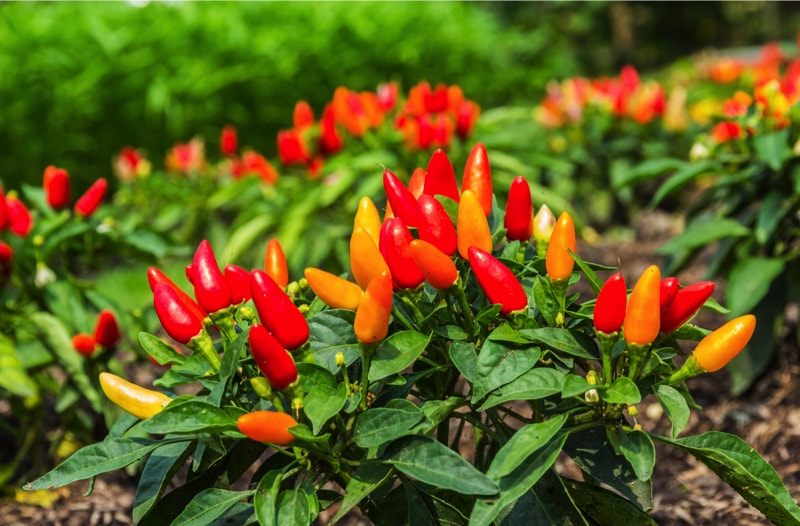 Spicy chili colorful planting in the garden.
Spicy chili colorful planting in the garden.
Health Benefits of Common Everyday Herbs That Grow Well Indoors
So what types are easy to grow herbs? When it comes to planting herbs inside, what are the best herbs to grow indoors? This isn’t an exhaustive list and whatever herbs you decide try growing indoors, just give anything a go, experiment, and before long, you’ll know what types of herbs thrive best in your home environment, but here are a few to start you off
Marjoram
Also known as Sweet Marjoram, or knotted marjoram, it is a part of the Mint family. It is also one of the most common and popular herbs used in the Mediterranean. Grown and used for both its medicinal properties as well as its culinary taste, it is commonly used to flavor soups, sauces, salads, and meat dishes.
It has a delicate sweet flavor, along with a subtle slightly spicy pungent taste. It is used as a herbal health remedy for cardiovascular health as well as an anti-inflammatory and also supposedly having neurological and emotional benefits
Rosemary
Native to the Mediterranaean, Rosemary is a charmingly fragrant herb that is the perfect pot herb to have in your kitchen garden. It is one of the few herbs recognized for its health benefiting properties as well as its nutritional value, being a good source of iron, calcium and Vitamin B6.
Also a member of the Mint family, its botanical name is Rosmarinus officinalis, and it was traditionally used as a health giving herb to help alleviate muscle pain, boost the immune and circulatory system, supposedly to improve memory, and also to promote hair growth.
Known as a rich source of antioxidants and anti-inflammatory compounds, Rosemary has numerous health benefits, and one of the more recent developments concerning Rosemary is that food scientists have discovered that rosemary, oregano and marjoram contain compounds that may have the benefits to potentially manage type 2 diabetes much in the same way as some of the currently prescribed diabetes drugs.
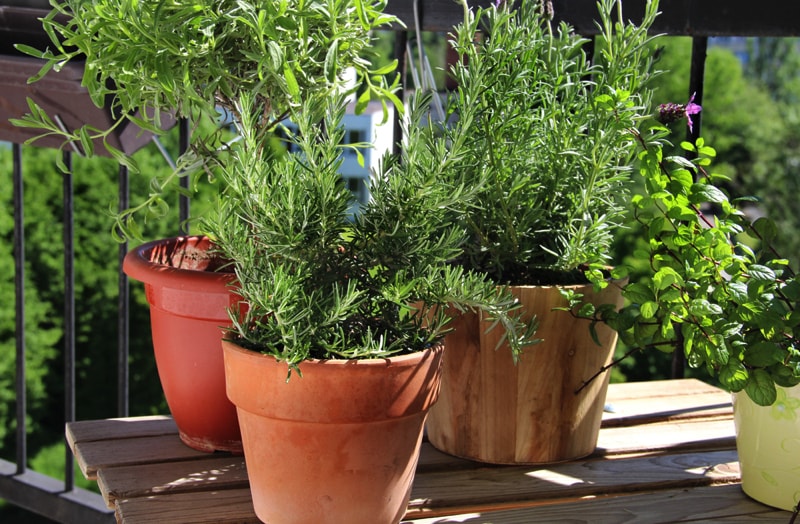 Rosemary, mint, lavender and other herbs in the pot.
Rosemary, mint, lavender and other herbs in the pot.
Mint
There are many types of mint within the Mint family. Such as spearmint, peppermint, wild mint, along with a number of others. Mint,also known as mentha has one of the highest antioxidant capacities of any food so its no wonder that Mint oil is often used in toothpaste, gum, candy and beauty products while the leaves are used either fresh or dried for teas and in food.
Mint has been studied for its effectiveness in relieving seasonal allergy symptoms, and is proving promising as a possible natural treatment. Mint also contains menthol, which is why it is shown to have positive impacts on colds and because it also a calming and soothing herb it is often used for people with upset stomachs or indigestion, and is a potential preventative for gastric ulcers in susceptible people.
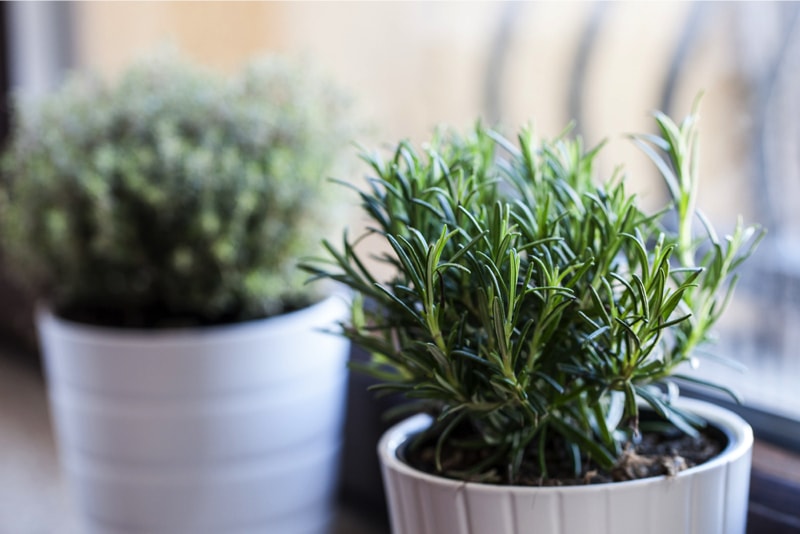 Rosemary in white pot with other white pot herb as background.
Rosemary in white pot with other white pot herb as background.
Coriander or Cilantro
To avoid the ongoing confusion around the naming of this herb, in the United States, the leaves of the plant are referred to as cilantro (the Spanish translation) and the seeds which are often used in Asian cooking, are referred to as coriander.
A lot of recent studies have suggested that the consumption of herbal plants like cilantro decreases the risk of obesity, diabetes and cardiovascular illness, whilst also promoting healthy skin and hair and increased energy levels.
Cilantro has an high antioxidant content. The oil extracted from the leaves has been shown to inhibit the oxidation process when added to other foods, effectively delaying or even preventing spoilage. The leaves of Cilantro are commonly used in many Asian (and Oriental) dishes. The flavor of the leaves is distinct and very appealing, adding significant flavor benefits to many of these dishes, either during the cooking process or as a garnish whilst serving.
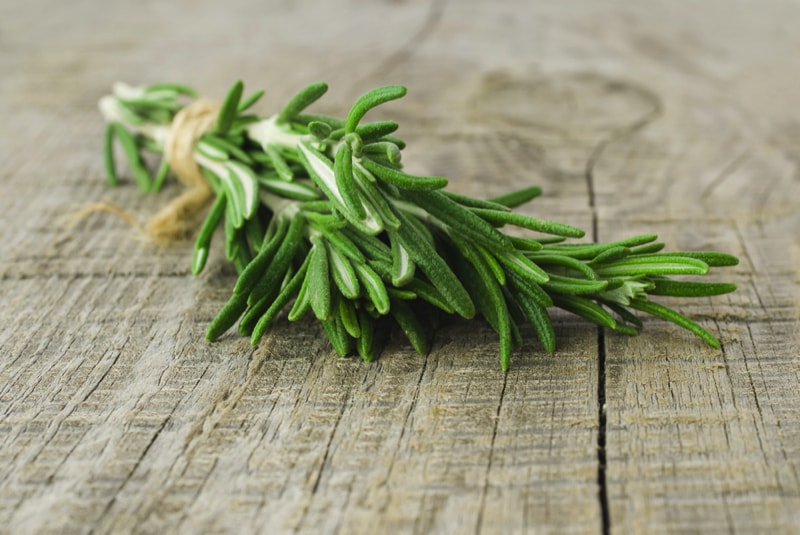 Rosemary bound on a wooden board
Rosemary bound on a wooden board
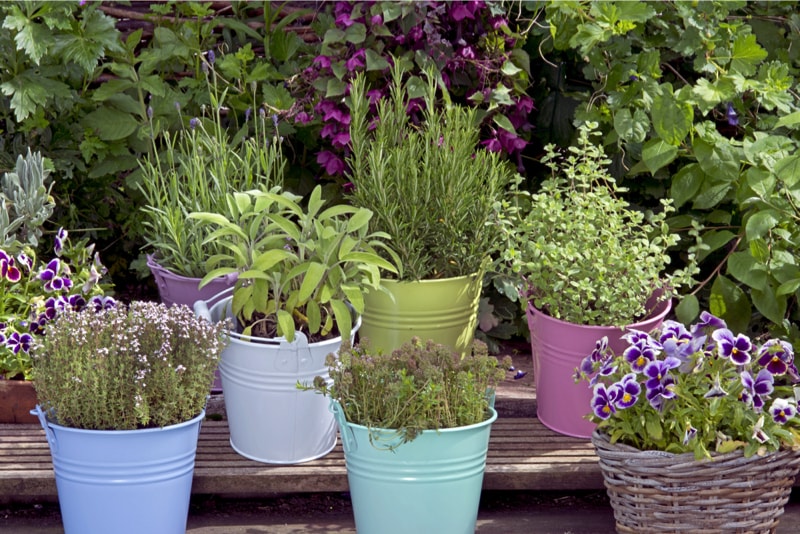 Mix of herbs in colored buckets in garden.
Mix of herbs in colored buckets in garden.
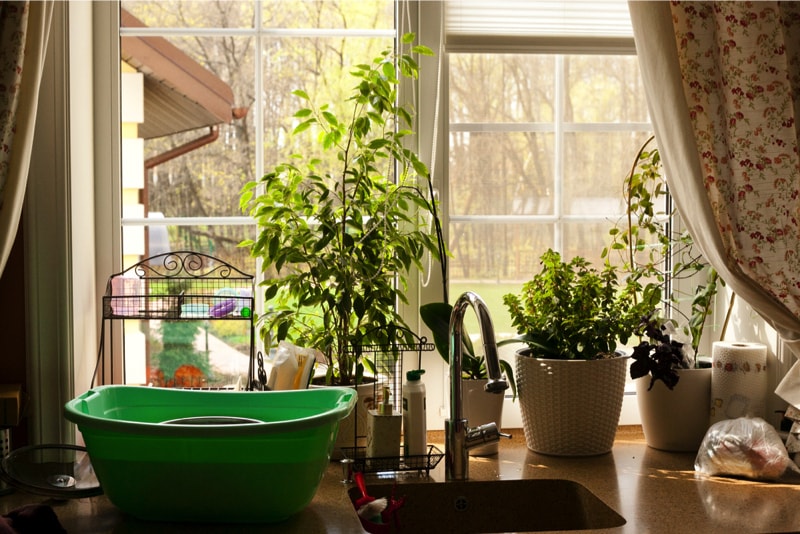 Kitchen window garden view plants
Kitchen window garden view plants
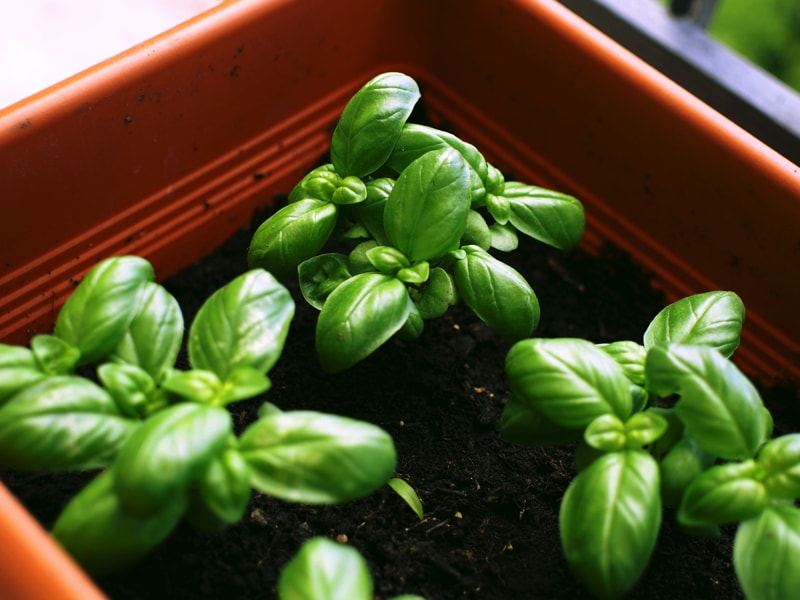 Grow Basil pot -Italian Basil growing small plants planted in a garden pot
Grow Basil pot -Italian Basil growing small plants planted in a garden pot
Basil
This can be a tricky herb to grow. It seems it either loves its environment or not, and that will determine whether or not you end up with a bumper crop or not. Most ‘kitchen gardeners’ yearn for basil in their indoor crop. If you have plenty of sun and the right temperatures indoors, it should thrive, but we would suggest that you don’t keep it on a cool windowsill. Basil leaves don’t like cool air. This will cause the leaves to droop and fade after a short time. It prefers a consistent indoor temperature in the 70s both day and night.
The health benefits of Basil include the reduction of inflammation and swelling with studies Royal Pharmaceutical Society’s annual event showing reductions in swelling of up to 73% within 24 hours following treatment.
Rich in antioxidants, Basil has been shown in other studies to be helpful in preventing some of the effects of aging, by preventing damage to the liver, heart and brain caused by some free radicals.
Chives
Chives come from the allium family of vegetables and herbs. (These include the likes of garlic, scallions, onions and leeks) Allium vegetables have been cultivated for centuries, not only their characteristic, pungent flavors but also for their medicinal properties. Chives make a great addition to many culinary foods, such as egg and cheese dishes, potato salads, sauces and as toppings for many soups.
The stiff, hollow, tubular leaves of chives are similar to that of spring onions, but significantly smaller in diameter.
Chives are a nutrient-dense food. They are low in calories but are high in vitamins, minerals and antioxidants. Interestingly, One tablespoon of chopped chives contains only 1 calorie, whilst providing 3% of the daily value of both vitamins A and C. A single serving of chives also contains a small amount other essential vitamins and minerals.
Allium vegetables have been studied extensively in recent times in relation to cancer. Allium vegetables showed some potential to inhibit cancer cell growth in stomach and colorectal cancers, and also in regards to prostate cancers, en with high intakes of allium vegetables appeared to have the lowest risk for prostate cancer.
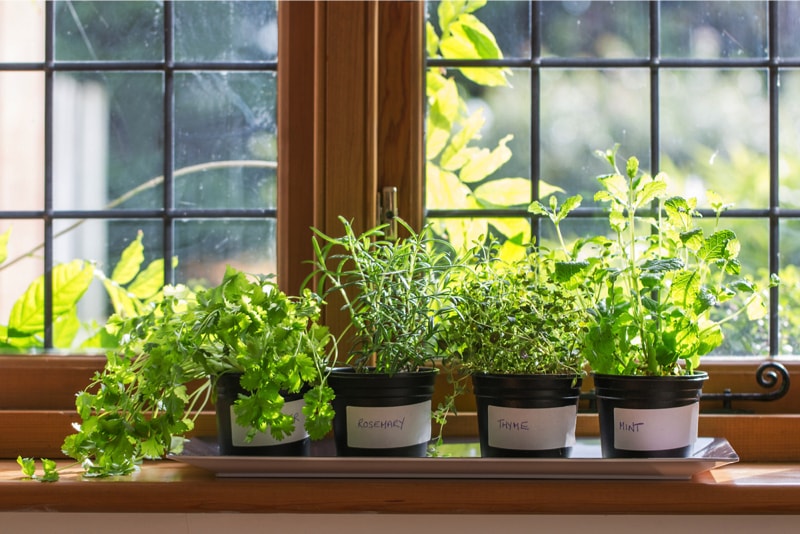 Herbs in plant pots growing on a windowsill.
Herbs in plant pots growing on a windowsill.
Thyme
Thyme herb is packed with numerous health benefiting phyto-nutrients (plant derived compounds), minerals and vitamins that are essential for overall wellness. One of the most popular among the culinary herb plants.
The essential oil of common thyme (Thymus vulgaris) – usually referred to as “oil of thyme” – contains 20-54% thymol. Thymol belongs to a naturally-occurring class of compounds known as “biocides” (substances that can destroy harmful organisms). When thymus is used alongside other biocides, it has strong antimicrobial attributes.
Acne, High Blood Pressure, and some cancers have been shown to be beneficially treated with thyme and its oils. One particular study in Turkey on the effects of Wild Thyme (Thymus serpyllum) on breast cancer activity and reported in the journal Nutrition and Cancer indicated that Wild Thyme induced cell death in the breast cancer cells. The study authors consequently concluded that Wild Thyme “may be a promising candidate in the development of novel therapeutic drugs for breast cancer treatment.”
The flowers, leaves and oil of the thyme herb are also often used by in the treatment of bedwetting, diarrhea, stomach ache, arthritis, colic, sore throat, bronchitis, flatulence and also as a diuretic.
Peppermint
Peppermint has a long history of use in herbal medicine and aromatherapy. It is also used for adding flavor or fragrance to several foods, cosmetics, soaps, toothpastes, mouthwashes, and other products.
Peppermint oil is a concentrated oil made from the peppermint plant which is extracted by steam distillation from the whole fresh or partly dried plant before it starts to flower. As with many herbs, it is the oily that contains the agents responsible for the health effects.
Many studies have shown that peppermint oil can improve pain management in irritable bowel syndrome. It appears to work by relaxing the smooth muscles in the colon, which relieves pain experienced during bowel movements. It also well renown for helping to reduce abdominal bloating, or indigestion.
There are also some studies that indicate when peppermint is used in aromatherapy, it can help fight nausea. In a study of over 1,100 women during labor, peppermint aromatherapy caused significant reductions in nausea.
Peppermint has also been indicated to show benefits with the following conditions; car sickness, treating colds and flu, relieving tension headaches and migraines, and calming skin irritations and itchiness.
Dill
Dill is a unique perennial herb with a pleasant anise-like flavor. Its sprigs (leaves) as well as seeds are employed as seasoning in many cuisines around the world. A member in the Umbelliferae family, a large group of flowering herbs and spices that also include caraway, parsley, cumin, and fennel.
Dill contains many plant derived chemical compounds that are known to have anti-oxidant, disease preventative, and health promoting properties. It is rich in vitamins like Vitamin A, Vitamin C, niacin, and pyridoxine as well as also being high in dietary fibre and many minerals like copper, potassium, manganese, iron and magnesium.
Dill leaves and seeds contain a number of essential oils that have shown potential health benefits; such as possibly reducing blood sugar levels in diabetics and antioxidant and antiseptic properties.
Dill herb has all the characteristics to consider it as a very valuable food component. 100 g of dill weed provides only 43 calories, but its phyto-nutrients profile is no less than any other high-calorie food source; be it nuts, pulses, cereals, or even a meat group.
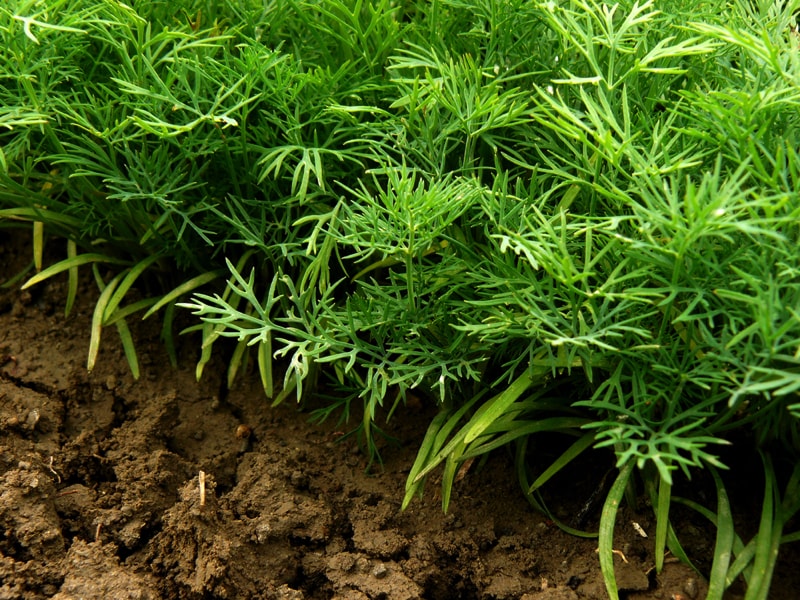 Green dill plants growing on bed.
Green dill plants growing on bed.
Parsley
Parsley is a popular culinary and medicinal herb. Parsley is often used to enhance the flavor or presentation of a dish, commonly used as a garnish or as an afterthought. It is quite unique in that it contains antioxidants, and disease preventing properties.
A very leafy herb that grows prolifically, it is a small plant featuring dark-green leaves that resemble coriander (cilantro) leaves, especially in the flat-leaf variety. However, its leaves are larger by size and milder in flavor than that of leaf-coriander.
Parsley has been linked to a number of health benefits. A flavanol found in parsley and known as Myricetin has displayed chemo-preventative effects on skin cancers. Parsley is one of a few foods to contain the highest levels of Myricetin. Parsley has also been linked to having positive effects on other cancer tumors. Myricetin has also been evaluated as a possible treatment or preventative for diabetes due to in vitro studies indicating it may possibly lower blood sugar levels
Parsley and other green herbs and vegetables that contain high amounts of chlorophyll have been shown to be effective at blocking the carcinogenic effects of grilling foods at a high temperatures, so it makes sense to include parsley on your plate when enjoying barbecued foods.
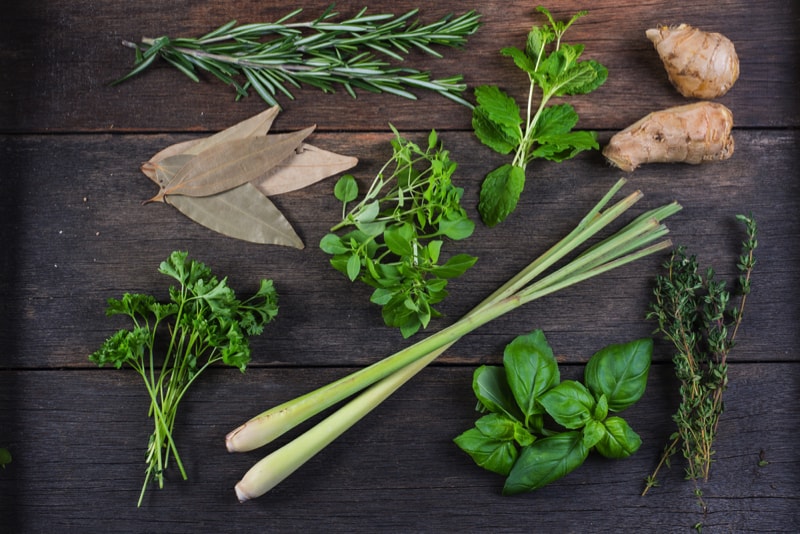 Freshly clipped herbs on wooden background.
Freshly clipped herbs on wooden background.
Oregano
Oregano is a wonderful perennial culinary and medicinal herb. Long recognized as one of the “functional foods” due to its nutritional, anti-oxidants and disease preventing properties. The herb, whose name means “delight of the mountains” in Greek, is native to the Mediterranean region.
Oregano has been used to treat respiratory tract disorders, gastrointestinal disorders, menstrual cramps, and urinary tract disorders. Being rich in dietary fiber, manganese, Vitamin K, iron, vitamin E, calcium, omega fatty acids, and tryptophan, it is an amazing herb that can aid in bone growth, and maintaining bone density.
It has also been shown to provide antimicrobial properties due to an ingredient called carvacol. Some researchers have even indicated that the essential oil within Oregano can kill hospital superbugs. Professor Vyv Salisbury, who was part of the research, said “We have done a few preliminary tests and have found that the essential oil from the oregano kills MRSA at a dilution 1 to 1,000. The tests show that the oil kills MRSA both as a liquid and as a vapor and its antimicrobial activity is not diminished by heating in boiling water.”
Aside from this, Oregano also displays anti-inflammatory properties, cancer protective properties along with a whole raft of other health benefits. This is certainly one herb, you’ll want to include in your diet.
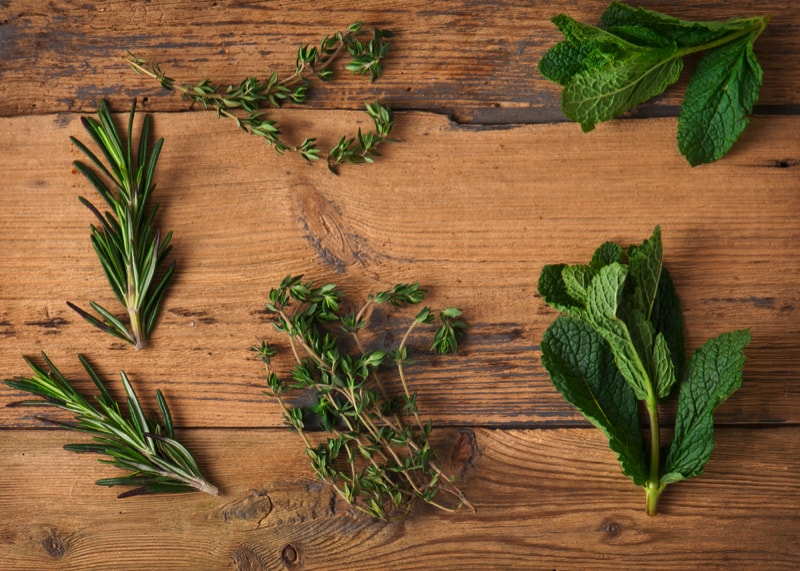 Freshly clipped herbs on wooden background.
Freshly clipped herbs on wooden background.
Sage
The sage plant has gray-green edible leaves and flowers. Sage has a long history of medicinal use for a wide variety of ailments ranging from mental disorders to gastrointestinal discomfort. Due to its high antioxidant capacity, sage has been shown to help protect the body from cell damage caused by free radicals.
Sage is one of the more popular herbs. It holds numerous virtues and has long been recognized as the guardian of herbs. It has been used in both European and Chinese herbal medicines for its health promoting and disease preventing properties for centuries.
One particular benefit relates to a study published in Complimentary Theories in Medicine, whereby 40 patients with diabetes and high cholesterol were given a sage leaf extract for 3 months. At the end of the trial, the participants showed a lower fasting glucose, HbA1c, total cholesterol, triglyceride and LDL (the bad cholesterol levels), but high HDL (good cholesterol).
Another study of patients with mild to moderate Alzheimer’s disease who were given either a sage extract or a placebo for 4 months, revealed that those given the sage extract showed an improvement in cognition as well as less agitation compared to the placebo group.
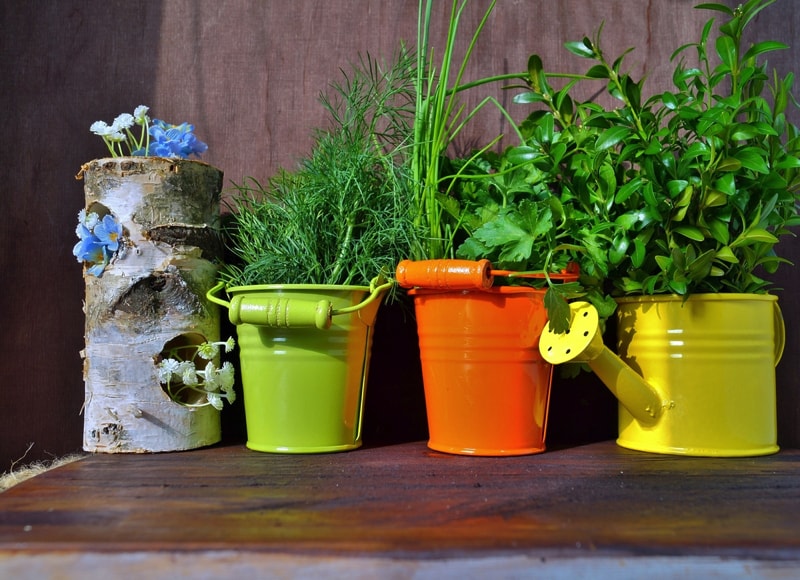 Fresh herbs in the kitchen on a wooden table
Fresh herbs in the kitchen on a wooden table
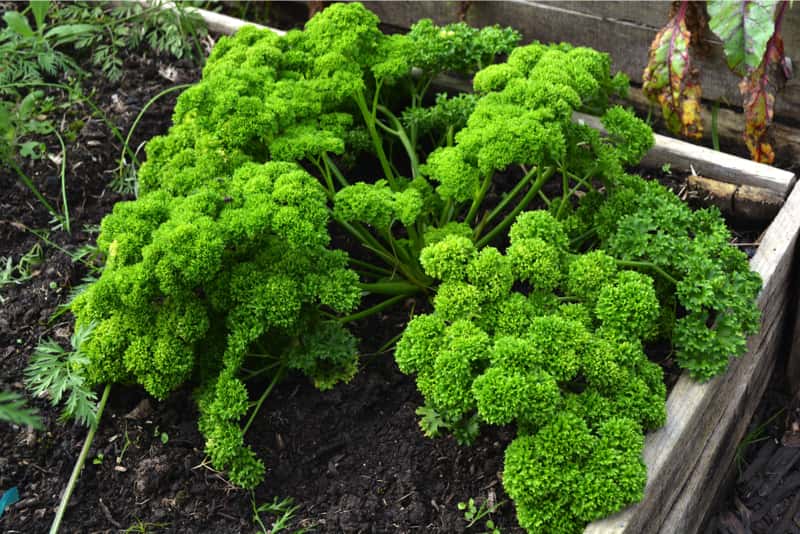 Top view on a big bunch of fresh healthy green parsley in an organic vegetable and herb garden.
Top view on a big bunch of fresh healthy green parsley in an organic vegetable and herb garden.
Please note: Many of the health benefits stated in this article many be subject to further studies and testing. We are not suggesting that any of these herbs are able to treat, prevent or cure any ailment, disease or condition, merely that they have potential positive benefits to overall health.
References: Medical News Today
